On September 2 at the ultra-deep-sea Stones* field in the Gulf of Mexico, oil production began on board FPSO Turritella, a floating production, storage, and offloading (FPSO) vessel** owned and operated by a consortium that includes NYK and has been entrusted by Shell Offshore Inc., a group of Royal Dutch Shell plc., to lead the FPSO operation.
FPSO Turritella is the fourth FPSO vessel for NYK. The vessel makes use of a state-of-the-art turret*** that allows the vessel to quickly flee from hurricanes that frequently occur in the area.

The Stones field is the deepest (2,900 meters below the surface) an FPSO has ever operated. This FPSO is owned by a shareholder consortium comprising SBM Offshore N.V. (Netherlands) and a joint venture company between NYK and the Mitsubishi Corporation. The shareholder consortium has a 10-year time charter contract with Shell Offshore Inc. to operate the FSPO.
In accordance with its “More Than Shipping 2018” medium-term management plan, NYK will continue to make use of its extensive technical know-how to expand and develop its business in the offshore industry, which is expected to grow remarkably.
Outline of FPSO
(1) Oil processing capacity 60,000 barrels of oil per day
(2) Gas processing capacity 15 million standard cubic feet per day
(3) Oil storage capacity 800,000 barrels
(4) Mooring Type Disconnectable internal turret
(5) Term Firm 10 years + Optional 10 years
* Stones field
An ultra-deep-sea field in the Gulf of Mexico 2,900 meters below the surface and approximately 320 kilometers off the shore of the U.S. state of Louisiana.
** FPSO
An FPSO vessel is an offshore installation that produces crude oil by separating solids, water, and gases from liquid drawn from reservoirs beneath the seabed and storing it until it is offloaded to shuttle tankers or export tankers.
*** Turret
A detachable buoy that allows the vessel to turn in place during normal weather conditions and, if a heavy storm or hurricane approaches, disconnect the mooring lines and risers from the well system and sail to a safe area.
Source: NYK